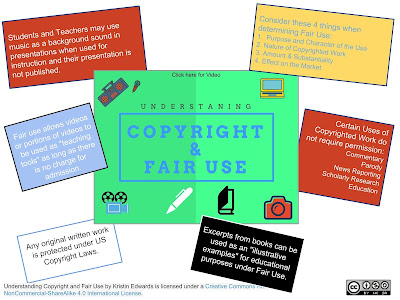So...What does this mean for teachers and students? How can I ensure that I give credit where credit is due, and receive credit for my own original works?
First, let's take a look at Fair Use.
Fair Use allows anyone to use copyrighted works or portions of copyrighted works for commentary, parody, news reporting, scholarly research or educational purposes.
Here are a few instances in education that would be considered "FAIR USE":
- using a copyrighted motion picture for instructional purposes (no admission can be charged)
- single classroom use of copyrighted material for instructional purposes
- use of music in the background of an instructional classroom presentation as long as the presentation is not published on the web
- transforming copyrighted material into a pedagogical tool
- use of illustrative example excerpts from a book; not the entire work
When considering fair use the US Government Copyright Law evaluates these four factors when considering Fair Use:
- Purpose & Character of the Use
- Does the use provide business benefit or financial gain?
- Nature of the copyrighted work
- Purely factual works are more likely to be considered fair use than creative works.
- Amount & Substantiality
- How much of the work will be used?
- Effect on the market
- Will use cause economic loss to the copyright holder?
If you buy a copyrighted work such as a book, movie, or music you can lend, resale, or dispose of the copyrighted work, however, you cannot reproduce or perform the work. Copyrighted works that are found and accessible on a public domain such as a Google Search are not considered fair use and proper permissions must be attained before using the material.
Rule of thumb: When in doubt, ask permission!!
Creative Commons licensing is the next thing we will consider.
Creative Commons works alongside the given copyright of a work to allow for easy sharing and use of copyrighted material. Check out this video, provided by CC, to gain a better understanding of what Creative Commons is and can offer. I can share this video even though I am not the creator because the CC License says that I can share and adapt this work as long as I give proper attribution.
Using a Creative Commons license on your original works is easy as well. Visit the Creative Commons Choose a License site, fill in your information and choose how you would like others to use your material. The site provides an embed code for websites and an image of the license terms to add to your work.
Example:
 This CC license means you can share and adapt under the following terms; you give appropriate attribution, indicate if changes were made, use is non-commercial, and share alike (the user shares what he or she makes from this work).
This CC license means you can share and adapt under the following terms; you give appropriate attribution, indicate if changes were made, use is non-commercial, and share alike (the user shares what he or she makes from this work).
Google Image Search allows you to search for CC licenses. When searching simply click images, search tools, usage rights to choose the type of license you are looking for. If you choose an image that is not filtered by license it is best to ask permission before using.
Other usage rights include:
- Labeled for reuse with modification
- Labeled for reuse
- Labeled for noncommercial reuse with modification
- Labeled for noncommercial reuse
Flickr Creative Commons is another resource to use when searching for images by CC licenses.
Photos for Class, created by the creators of Storyboard That, is a great resource for teachers and is safe for students. The Photos for Class site works with Flickr and the CC license. When an image is downloaded, proper citation and attribution is downloaded as well. This is great for teaching students about copyright and ownership!
If you are thinking that this is all too much and you will never remember it all, here is a quick infographic that I created using a combo of Canva and Google Drawings to help me process all of this important information, and here is a link to a short video created by the Copyright Clearance Center that is helpful, too!
Remember, when in doubt ask permission!
CC Video License - No changes were made
Kristin Edwards


No comments:
Post a Comment